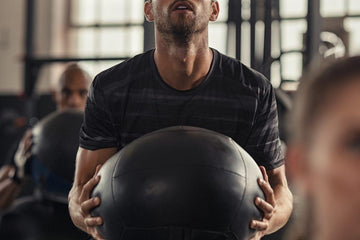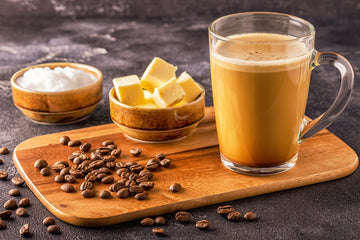Functional training is a concept that has gained a lot of popularity in recent years, both in fitness and rehabilitation. It focuses on improving physical performance through exercises that mimic everyday movements and strengthen the entire body. In this post, we'll explain what functional training is, how it differs from traditional strength training, and how you can use it to build functional strength.
What is functional training?
Functional training is a training method that aims to improve movements that you perform in daily life or in sports activities. Unlike isolated exercises that target only one muscle group (such as bicep curls), functional training focuses on exercises that target multiple muscle groups at once and simulate complex, multi-dimensional movements. The goal is to improve mobility, stability, strength, endurance and coordination in order to increase performance in real life situations.
The basic principles of functional training
1. Whole body approach:
•Functional training involves several muscle groups simultaneously, often in complex, multi-joint movements. This promotes coordination and ensures that the muscles work as a unit, which is important in everyday movements.
2. Dynamic movements:
•Exercises in functional training are usually dynamic and include movements that take the body in different directions (eg twisting, bending, stretching). This prepares the body for the diverse demands of daily life or sporting activities.
3. Core training:
•The core muscles play a central role in functional training. A strong core is crucial for stability and power transfer throughout the body, which prevents injuries and increases performance.
4. Everyday movements:
•Exercises are designed to mimic movements commonly performed in everyday life, such as lifting objects, twisting the body, or walking on uneven terrain.
Functional strength: what does it mean?
Functional strength refers to the ability to generate and use force in a way that is directly transferable to everyday movements or sporting activities. Unlike traditional strength training, which often only trains individual muscle groups in isolation, functional strength training aims to improve the synergy between different muscle groups. This allows you to go through everyday life more efficiently and safely, whether it's carrying groceries, playing with the kids or practicing a sport.
Benefits of Functional Training
1. Improving everyday performance:
•By mimicking real movements, your ability to perform everyday tasks is improved. Lifting, carrying, bending and twisting become easier and safer because your muscles work in better coordination.
2. Injury Prevention:
•Functional training strengthens the stabilizing muscles and improves balance and coordination, which significantly reduces the risk of injuries in everyday life or during sports.
3. Whole body conditioning:
•Unlike traditional strength training, which often only trains specific muscle groups, functional training provides comprehensive conditioning of the entire body, including endurance, flexibility and strength.
4. Increase mobility:
•Functional training promotes joint mobility by including movements in all directions. This is particularly important for maintaining mobility in old age.
5. Time efficiency:
•Because functional training targets multiple muscle groups simultaneously, it is extremely time efficient. A complete workout can be completed in a short period of time, improving strength, endurance, balance and flexibility.
Effective exercises in functional training
1. Squats:
•Squats are a fundamental exercise in functional training. They train the leg and glute muscles, the core and the stability of the knee joints. They are extremely useful for everyday movements such as lifting heavy objects.
2. Lunges:
•Lunges promote balance, strength and mobility in the legs and core. They simulate walking or climbing stairs, which makes them an everyday exercise.
3. Planks:
•Planks are an excellent core strengthening exercise. They improve stability and help protect the back by strengthening the abdominal muscles.
4. Kettlebell Swings:
•Kettlebell swings are a dynamic exercise that improves strength, endurance and coordination. They strengthen the entire body, especially the lower back, glutes and core.
5. Farmer's Walk (carrying weights):
•This exercise simulates carrying heavy objects in everyday life and strengthens the entire body, especially grip strength, shoulders, back and core.
6. Burpees:
•Burpees are a full-body exercise that builds strength, endurance and explosiveness. They combine squats, push-ups and jumps and are very effective at increasing the heart rate and burning calories.
Integration of functional training into everyday life
Functional training can be easily incorporated into your daily routine, whether you are a beginner or an advanced athlete. It can be used as a standalone workout or as a supplement to an existing fitness program. Here are some tips for integration:
• Start with basic movements: If you're new to functional training, start with basic movements like squats, lunges and planks. Gradually add more complex exercises as your strength and flexibility increase.
• Use everyday objects: Functional training does not always require special equipment. Use everyday objects such as water bottles, heavy bags or steps to perform your exercises.
• Combine with cardio: Combine functional training with cardio to improve both your endurance and strength. Exercises like burpees or kettlebell swings are ideal for combining cardiovascular exercise and strength training.
Conclusion
Functional training is a versatile and extremely effective training method that not only improves physical fitness, but also increases performance in everyday life and in sports. By imitating everyday movements and building functional strength, you can prevent injuries, improve your mobility and become fitter and healthier overall. Whether you are a fitness newbie or an experienced athlete, functional training gives you the tools to reach your full physical potential.





